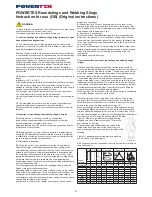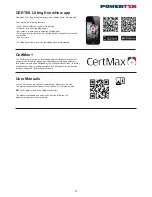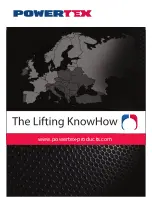
2
POWERTEX Roundslings and Webbing Slings
Instruction for use (GB) (Original instructions)
WARNING
• Failure to follow the regulations of this instruction for use may cause
serious consequences such as risk of injury.
• Read and understand these instructions before use.
1 Use of roundslings and webbing slings (sling) in adverse condi-
tions or hazardous applications
1.1
The material from which slings are manufactured has selective
resistance to chemicals. Polyester (PES) is resistant to most mineral
acids but is damaged by alkalis;
Solutions of acids or alkalis which are harmless can become sufficient
-
ly concentrated by evaporation to cause damage. Contaminated slings
should be taken out of service at once, soaked in cold water, dried
naturally and referred to a competent person for examination.
Slings with grade 8 fittings and multi-leg slings with grade 8 master
links should not be used in acidic conditions. Contact with acids or
acidic fumes causes hydrogen embrittlement to grade 8 materials.
If exposure to chemicals is likely, the manufacturer or supplier should
be consulted.
1.2
Slings are suitable for use and storage in the following temperature
ranges:
a) polyester: -40°C to 100°C.
At low temperatures ice formation will take place if moisture is present.
This may act as a cutting agent and an abrasive causing internal
damage to the sling. Further, ice will lessen the flexibility of the sling, in
extreme cases rendering it unserviceable for use.
These ranges vary in a chemical environment, in which case the ad-
vice of the manufacturer or supplier should be sought.
Limited indirect ambient heating, within these ranges, is acceptable for
drying.
1.3
The man-made fibres from which the slings is produced are sus
-
ceptible to degradation if exposed to ultra-violet radiation.
Slings should not be stored in direct sunlight or sources of ultra-violet
radiation.
2 Inspection of roundslings and webbing slings in service
2.1
Before first use of the sling it should be ensured that:
a)
the sling corresponds precisely to that specified on the order;
b)
the manufacturer’s certificate is to hand;
c)
the identification and WLL marked on the sling correspond with the
information on the certificate.
2.2
Before each use, the sling should be inspected for defects and to
ensure that the identification and specification are correct. A sling that
is unidentified or defective should never be used, but should be refer
-
red to a competent person for examination.
EC-Declaration is available.
2.3
During the period of use, frequent checks should be made for
defects or damage, including damage concealed by soiling, which
might affect the continued safe use of the sling. These checks should
extend to any fittings and lifting accessories used in association with
the sling. If any doubt exists as to the fitness for use, or if any of the
required markings have been lost or become illegible, the sling should
be removed from service for examination by a competent person.
Any damage evident in the cover (roundsling) indicates potential dama-
ge to the loadbearing core.
The following are examples of defects or damage likely to affect the
fitness of slings for continued safe use:
a)
Surface chafe. In normal use, some chafing will occur to the surface
fibres of the cover (roundsling). This is normal and has little effect. Any
substantial chafe, particularly localized, should be viewed critically.
Local abrasion, as distinct from general wear, can be caused by sharp
edges whilst the sling is under tension,
and can lead to the cover (roundsling) becoming cut, or/and cause
serious loss of strength.
b)
Roundsling: Cuts. Cross or longitudinal cuts in the cover, or any
damage to the stitching, raise serious doubts as to the integrity of the
core. Webbing sling: Cross or longitudinal cuts, cuts or chafe damage
to selvedges, cuts to stitching or eyes.
c)
Exposed core (roundsling).
d)
Chemical attack. Chemical attack results in local weakening and
softening of the material. This is indicated by flaking of the cover/sur
-
face which may be plucked or rubbed off. Any signs of chemical attack
to the cover (roundsling) raise serious doubts as to the integrity of the
core (roundsling).
e)
Heat or friction damage. This is indicated by the fibres of the cover/
surface material taking on a glazed appearance and in extreme cases,
fusion of the fibres can occur, indicating a weakening of the core
(roundsling).
f)
Damaged or deformed fittings.
3 Correct selection and use of roundslings and webbing slings
(slings)
3.1
When selecting and specifying slings, consideration should be
given to the required working load limit, taking into account the mode of
use and the nature of the load to be lifted. The size, shape and weight
of the load, together with the intended method of use, working environ-
ment and nature of the load, all affect the correct selection.
The selected sling should be both strong enough and of the correct
length for the mode of use. If more than one sling is used to lift a load,
these slings should be identical. The material from which the slings is
made should not be affected adversely by the environment or the load.
Consideration should also be given to ancillary fittings and lifting de
-
vices which should be compatible with the sling(s).
Webbing slings: The termination of the sling should also be considered
i.e. whether fittings or soft eyes are required.
3.2
Webbing slings: When using slings with soft eyes, the minimum
eye length for a sling for use with a hook should be not less than 3,5
times the maximum thickness of the hook and in any event the angle
formed in the eye of the sling should not exceed 20°.
When connecting a sling with soft eyes to a lifting appliance, the part
of the lifting appliance which bears on the sling should be essentially
straight, unless the bearing width of the sling is not more than 75 mm
in which case the radius of curvature of the lifting appliance attachment
should be at least 0,75 times the bearing width of the sling.
Figure D1 illustrates the problem of accommodating
webbing on a hook of radius less than 0,75 times the
bearing width of the sling.
Wide webbings may be affected by the radius of the
inside of the hook as a result of the curvature of the
hook preventing uniform loading across the width of the
webbing.
Figure D1 inadequate accommodation of a webbing
eye on a hook of too small radius
3.3
Slings should not be overloaded: the correct mode factor should be
used (
see table 1
).
Angle of
inclination
1-leg U-lift Laced 1-leg angle
2-leg sling
3-, 4-leg sling
0°- 45° 45°- 60° 0°- 45° 45°- 60° 0°- 45°45°- 60°
Load factor 1
2
0,8
1,4
1
1,4
1
2,1
1,5
Colour
WLL ton
Lila
1,0
2,0
0,8
1,4
1,0
1,4
1,0
2,1
1,5
Green
2,0
4,0
1,6
2,8
2,0
2,8
2,0
4,2
3,0
Yellow
3,0
6,0
2,4
4,2
3,0
4,2
3,0
6,3
4,5
Grey
4,0
8,0
3,2
5,6
4,0
5,6
4,0
8,4
6,0
Red
5,0 10,0
4,0
7,0
5,0
7,0
5,0
10,5
7,5
Brown
6,0 12,0
4,8
8,4
6,0
8,4
6,0
12,6
9,0
Blue
8,0 16,0
6,4
11,2
8,0
11,2
8,0
16,8
12,0
Orange
10,0 20,0
8,0
14,0
10,0
14,0
10,0
21,0
15,0
Figure D1
Summary of Contents for Round sling
Page 8: ...8 ...
Page 10: ...www powertex products com ...










